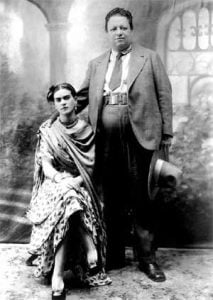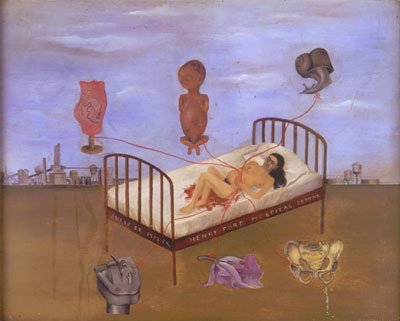“Feet, what do I want them for if I have wings to fly”, these magical words enunciated by Frida Kahlo define her in more ways than one. Faced with tribulations unimaginable to most people, Frida still lived life on her own terms, unrestricted and like a free bird. Before we delve into how she triumphed over obstacles in life and why she has come to be regarded as a feminist icon, let’s look at a few facts about her.
Early Life
Frida Kahlo was born in the year 1907 in Coyoacan, Mexico. For a large portion of her life, she was known as her husband Diego Rivera’s wife but she soon carved out a separate identity for herself as an artist and is now, fondly followed and remembered by not just the artistic community but by women and feminists alike.

Frida and Diego’s wedding photograph, 1929. Photo: Victor Reyes. Courtesy Throckmorton Fine Art, New York
Frida was also deeply involved in politics, and this is reflected in the fact that she declared her birth year to be 1910, the year of the start of the Mexican Revolution even though she was actually three years old at that time. At the age of six, a polio attack left her with a withered leg, and her physical trauma intensified after a near-death experience in an accident. Yet, Frida not only championed her way out of these physical struggles, she also undertook the accompanying emotionally tumultuous journey like a free, happy bird.
In addition to these visibly traumatizing physical difficulties, Frida’s relationship with her husband was also complicated. A liberal in the truest sense, Rivera found it difficult to be faithful to his wife. Consequently, they ended up getting divorced ten years into their marriage, only to get re-married the very same year. However, the relationship between them continued to be a trying one and they continued to be married without being lovers. Rivera continued to have affairs outside their marriage but was not accepting of Frida’s affairs, particularly with women.
Frida Kahlo – The Feminist?
An artist with physical disabilities and an emotionally challenging life was Frida Kahlo, why then is she remembered as a feminist icon? Frida’s uniqueness lay in the way she depicted herself in her paintings. She was a brilliant painter of herself and of things that came to her mind, as well as her sources of joys and sorrows, all of this she painted unfettered. Her expressions were not molded to fit the societally set standards of what was “acceptable” but she followed her heart and mind. This is evident in her self-image portrayals whereby she sports a unibrow as well as a moustache. Clearly, such an image does not conform to a patriarchal society’s image of a woman who has perfectly shaped eyebrows and definitely no moustache.

Self-Portrait with Hummingbird – Frida Kahlo
Women today have been conditioned in a manner whereby they project themselves in the manner demanded from them by society. Frida, even then, refused to do so. She set her own standards. She valued and celebrated characteristics that patriarchal society has labelled unfeminine and ugly. And so, she was a feminist.
Frida also dressed in a particular manner, very different from the Mexican women of that time whose attire consisted of pearls, suits, and hats. Frida’s fashion consisted of gay, Mexican tradition clothes – she adorned herself with clips, bows, ribbons, jewellery, scarves and costumes, and such dressing became an entrenched part of her identity. She sometimes also painted her dresses herself. Hence, she never bowed down to the required attire for “cultured” women in Mexico at that point of time. She challenged patriarchy in her own way. Some believe that she dressed in this particular manner to hide her deformities but her appreciation of herself through her paintings exhibits how much pride she took in her appearance.

Photo by APIC/Getty Images
Personal Life & Career
Frida’s bodily trials also resulted in her inability to give birth. She went through the ordeal of multiple miscarriages. These experiences, she brought to life through her paintings. A piece she created after a miscarriage in Detroit is an example of this. The background shows a barren, empty sky, reflecting her internal state of sorrow and emptiness. She herself is painted as a naked body on a hospital bed. This body is not one that would belong to models in magazines or the “perfect” bodies that form the subject-matter of other forms of art. This body is painted as that of a woman who has undergone the agony of miscarriage. Her breasts are enlarged, she lies in a pool of blood and her abdomen is swollen. This has been interpreted and viewed as a stark and realistic portrayal of issues particular to women post puberty i.e. menstruation, miscarriage and abortion. This canvas mirrored her unique experience as a woman. She did not disassociate from the trauma that these specific instances afflict on women, instead she tackled them head-on and used her art as an outlet and as a mechanism to share experiences, which may be common to other women but are not talked about or given adequate importance to. And so, even as an artist, she was revolutionary.

Frida Kahlo, Henry Ford Hospital 1932, Oil on metal panel, 305 x 350mm. Museo Dolores Olmedo Patino Mexico (Mexico City, Mexico)
© Banco de México and INBAL Mexico, 2004
Frida did not shy away from politics and joined the Mexican Communist Party in 1948. This also led to a kind of transformation in her art, which now began to incorporate Mexican folk culture. She visited America and criticized the rich for celebrating their money while the poor suffered every day. So committed was she to her cause that even a few days before her death, her flailing health did not prevent her from participating in a protest against the CIA invasion of Guatemala.
Nothing stopped Frida, not the society or her own infirmities. And so, Frida remains an enigmatic figure in feminist history, and continues to serve as a source of inspiration for women as well as the LGBTQ+ community.
References
Also read: FridaMoji Is Exactly The Upgrade Your Emoji Keyboard Needed!
Featured Image Credit: Frida Kahlo, 1941. Photo: Nickolas Muray © Nickolas Muray Photo Archives via Tate.org
About the author(s)
Yashvi is a corporate lawyer based out of Delhi.





Able to find good information from your blog articles.Great job! Keep it up! Dear friends if anyone looking forward to buy paintings from online? Just visit IndianArtZone from where you get a huge range of famous paintings from Indian Artists.